

The game of Kho-Kho based on natural principles of Physical and Mental development, is vigorous and fosters a healthy combative spirit among the youth. It is not merely after running but ‘Chase’ meaning thereby to try to overtake, to attempt, to catch by pursue. It calls for high order physical fitness, agility, speed, stamina, endurance, flexibility, presence of mind and a strong purposeful determination in a player. It also helps to increase the power of Decision-making, Dodging, Feinting and controlled sprinting makes the game exciting and interesting to watch. In short, the game of ‘Kho-Kho’ gives to the player the real joy of efforts, well and truly made, and to those who watch it, the thrill and satisfaction of having enjoyed fine sport. The play is governed by specific rules of the game approved by the Asian Kho-Kho Federation.
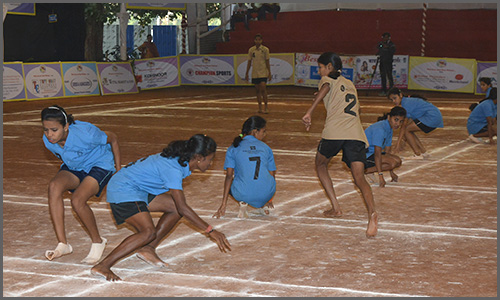
A good levelled field, admeasuring 29 mtrs. X 16 mtrs. with a 1.5 mtrs. lobby on all sides is required for the game of Kho-Kho. Two smooth, straight, round Wooden posts (diameter between 9 to 10 cms) without any sharp edges and a flat top fixed firmly in free zones at a distance of 23.5 mtrs. apart to which line of post is a tangent at midpoint, must be 120 cms. above the ground level.
The field has two Rectangles (16 x 2.75 mtrs.) beyond the ‘line of post’ and eight rectangles (16 x 03 mtrs.) with a centre distance of 2.55 m in between the two adjacent ones, called ‘Cross Lanes’. The Cross Lanes intersect at right angle a ‘Central Lane’ (23.5 x 0.3 mtrs.) running between the posts.

The Line of Post is 2.65 m from the centre of the adjacent Cross Lane. The intersection of Cross Lane with Central Lane makes a Square (30 x 30 Cms). ‘Waiting Block’ is an area beyond the End Lines and behind the free zones for Runners and reserves 1 mtr. wide outside the lobby.
The width of the lines is 3 cms. The dimensions are measured from edge to edge and therefore include the width of the lines.
The officials are appointed by competent authority. A match, to be judged, requires :
A Referee :
Generally supervises the conduct of the play, helps Umpires, synchronizes his watch with the watch of Time Keeper, checks time and score, announces scores and has right to penalize defaulting player of team. A referee declares the result of the match.
Two Umpires:
Umpires control the course of the play in their own half in general by moving in the lobby. Declare judgment on ‘put out’, compel the active chaser to act up-to the rules, get foul corrected, help the other umpire in discharge of duties.
Time Keeper:
Time Keeper keeps time of turn. Starts and closes the turn of a match. He declares the completion of each minute by raising his arm.
Scorers:
Scorers take down the order of the defenders. They record the points scored by the chasers, complete the score sheet and hand over it to the referee to declare to points scored and the result of the match.
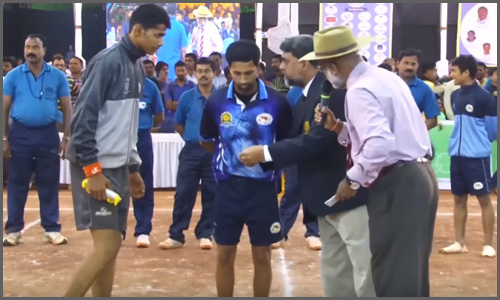
Two teams each of 15 players. 9 from 12 named for a match take field. Players are numbered 1 to 15 (height 10 cms in front and 20 cms on back with 2 cms width). Change of numbers is not allowed during a tournament.
Chasers:
Players of the team who sit in the Squares to chase the opponent team, with shoulder line parallel to the Central Lane, alternately face the 29 mtrs./24 mtrs. long boundary lines. Actual pursuer is the Attacker.
Runners:
Players of the team, who defend against chasing.
Defenders:
Runners are the players, who actually come inside the limits in a batch of three.
Substitutes:
Substitutes are allowed at the discretion of Referee on request of captain.

A match consists of two innings. An inning consists of chasing and running turns of 9 minutes each. An interval of 9 minutes after an inning and of 5 minutes in between the turns is given.
Start:
Start is indicated by the Time Keeper by blowing ‘one long followed by one short’ blast of whistle.
End:
End is declared by the Time Keeper by blowing a ‘long’ blast of whistle.
Result:
Side that chases out more opponents scores a win. Teams do not leave the ground till the result is announced.
Tie: Points are shared in a league match.
The Minimum Chase Method is adopted if a knock-out match ends in a tie after an extra inning (i.e. Third inning) The Minimum Chase Method means breaking tie in ‘Knock out’ match by noting the time to put out the first defender in the fourth inning and further innings, if need be. The minimum time needed to put out a defender entitles a team to win. Incomplete match for any reason is continued further with finished turns and same players in the same session.

‘Kho’ is known to have been given, when an attacker utters loudly and distinctly - the
Word ‘Kho’ (purporting to mean ‘GO, CHASE’), touching by hand a chaser from behind him. This in other words incorporates a relay ensuring coverage of a certain minimum distance by an attacker. Gentle touch, a smooth action is essential i.e. just a touch by hand. Chaser must not be pushed. Brake is applied to chasing, a violent exercise at times, braking pressure is applied on one leg. The direction of running determines the leg on which the braking pressure is applied.
Importance is attached to the method of sitting on the Square in modern Kho-Kho. Most advantageous is to sit on toes with thighs parallel to the ground and heels completely lifted up. Palms, with cup shape position placed just outside the Central & Cross lane, give the needed position placed just outside the Central & Cross lane, give the needed support. This is known as Parallel Toe method. Another is Bullet Toe method i.e. one toe nearer to the front line of square and another is a little behind the other one.
A basic difference in sitting on the square necessitates the last seated chaser - chaser nearest to post - to turn around the post clockwise or anti-clockwise after getting a Kho. Clockwise turning comes naturally to most, as left-handers are a rare commodity. At times chasers reduce the speed and rhythm of their chase for the slight advantage at the post to unnerve a defender.
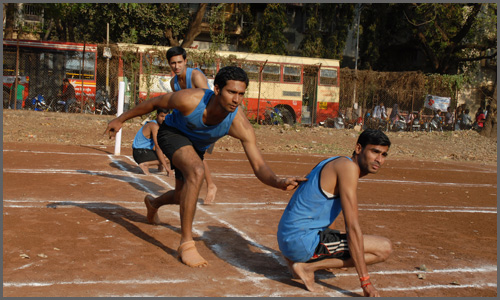
A Defender is ‘Out’ if:
a) If touched by the hand of an attacker without violating the rules of the game.
b) Goes out of limits i.e. loses contact of the ground inside limits.
c) Enters the field late. (i.e. Defender of a new batch enters into the field after two perfect Khos are given)
d) Warned once for touching a chaser and then touches again.
e) Does not enter the field from an entry zone.
Another of those rare skills adopted by the chasers which demands balance of body as well as mind, ability to sprint with great velocity and check the speed, almost coming to a halt, after hitting the target. The skill must be used very sparingly as ‘timing’ is most important. A defender moving traverse moving traverse to the direction of chasing, to cross the Central Lane or just running ahead may be within the sprinting distance of an attacker, but if the attacker tries to put out the defender by mere tagging, foul may be committed at the Central Lane or the defender may escape by fraction of a second and with a few inches to cover by. Therefore, by accelerating the speed an attacker covers up the distance and by bending extends his hand as long as possible to tap i.e. just touch the heel of the defender which at that time is nearest to him.
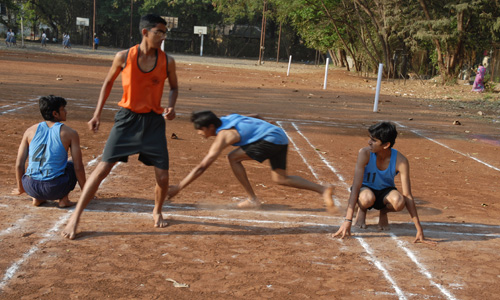
Though the real masters are very few, a frequently used technique of today. It demands high order of flexibility, sense of timing, observation and control over movements. In fact modern Kho-Kho is said to revolve around the Post. The Post has become important, strategic. Incidentally an attacker changes direction, when he turns round the Post and a defender many times has no escape but to go to Post.
Extension of his body to the maximum in the other half of the play field is possible only at the Post for an Attacker. At times a defender at the Post is not chased around but is intercepted near it. The Post can be held at elbow joint or even with the palm. The latter gives longer reach but it is a difficult skill and needs good amount of constant practice. There is an improvement over this, where in addition to palm, arm is also made use of. It is safer to put the foot touching the ground and nearer the Post in the rectangle but it restricts the reach of an attacker. In practice the leg should be in the field only, which helps to swing the hand for more reach, while the other foot is up in the air. The action of holding the Post and swinging the other arm should be simultaneous.
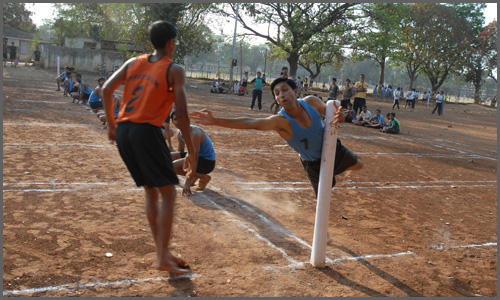
The position from where this skill can be adopted depends on an individual. The most common are first and second square from the Post. The player on the first square gets up after a Kho, leaps forward in either two or three steps and enacts this skill. From the second square either rushes directly on to the Post or halts momentarily at the first square, takes a position of giving a Kho but enacts the skill. The entire action is a beauty to watch, if done swiftly.
A defender must be chased immediately, wherever he is, if the desired result is not achieved by enacting this skill.
It is the judgment of a ‘Kho’ on the first cross lane from the posts by the defender that carries the moment. A wrong judgment will either force him to leave the Post and become an easy prey of chaser on the first square, who gets a Kho; or will glue him to the Post to be run over. There are several ways of affecting this skill. The built or height of a player does help. It all depends on how cleverly an attacker forces the defender into a wrong judgment of his intentions - to chase or to give Kho.
An attacker with his toe, firmly entrenched on the first lane from the posts uses movements of either body or hand or head and a straight look into the eyes of a defender to unnerve him and misjudge the intentions. In this action one hand must come nearer to the seated chaser. Whenever, a defender comes out in front of the seated chaser, baffled, he has to be put out by getting up almost at an angle of 450. The angle varies with the speed and the baffled condition of the defender. Therefore, the best way is to watch the defender, judge his speed and then taking correct direction to put him out.
This skill combined with the skill of ‘Touching at Post’ or ‘Pole Dive’ is very effective but the ‘timing’ mostly decides the effectiveness. In this skill waist part of the body is very important the effectiveness of this skill depends upon the smooth, swift and quick movement of waist.
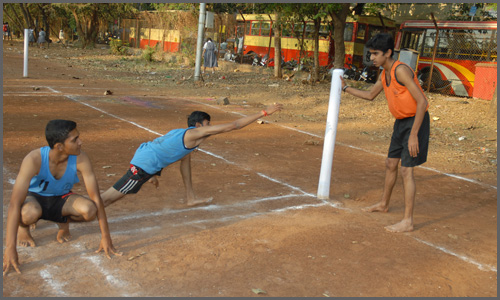
Chasing demands something more than mere running. Besides sprinting at an opportune time to tag the defender, it demands certain other skills to put out the opponent. Diving is one such skill. It is used to cover up distance, when a defender just cannot be touched by overcoming the distance with mere speed in chase and escapes by a few steps or tries to run away through the open space in a ‘game in four’ game. The aim should be waist part of the defender as it is the steadiest part of the body though the dupe or patty comes off from waist; an attacker can concentrate and achieve the success.
An attacker while getting up; and in full speed or immediately after turning around the Post can use the skill of dive. It is effective more on slower defenders and ‘game in four’ type defense and in sudden attack. Very few players use it as it involves fine judgment of speed of the defender, the distance to be covered and the confidence to execute it without causing injury and reduction in the speed of the chase. It requires high tone of flexibility and swing.

Chasers Remember!!
Sitting down and getting up is a unique feature of this game. Such an action is found only in this game. There is no momentum to the Chaser. He has to get into action and generate the speed. This is possible with high degree of agility and strengthened legs, waist and thighs.
It is equally important to ‘get up’ from the square as much as ‘sitting’ is. Concentration on a defender helps and controls chaser’s movements speed of getting up, covering ground on cross lane - whatever the style. ‘Ape’ and ‘Frog’ style gives stability but lowers down speed. The style can be adopted easily with least chances of shoulder line-foul. ‘Getting straight up’ is most ideal, hence most difficult to practice and employ. The instinct to pounce on a subject helps to adopt it effectively.
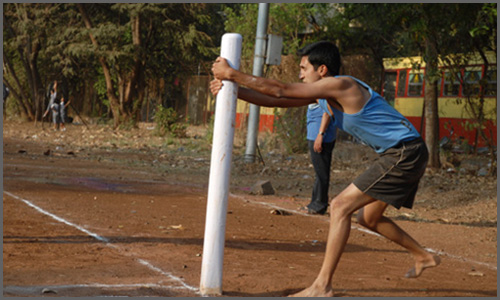
• Not a player but the entire team should chase.
• LOOK the ground, NAY, the Defender.
• To receive Kho is ritual. Do not wait or be eager or impatient for it.
• Shoulder line and not the movement of head give chaser direction.
• Cover (close one side) to avoid ‘dupe turned’ or palty.
• It helps to put forward that foot towards the ‘hunt’ is directed.
• Put out, if you can, but reducing the distance from defender is a must.
• Speed for chase is an asset not an ultimate goal.
• Hold the post by the palms.
• If a defender can be put out by chasing, do not adopt ‘Touching at Post’ or ‘Dive’.
• Do not force two defenders of sound in ‘game in four defense’ towards the Post.
• One indication of foul, it is safe to take the indicated direction and give a perfect Kho quickly.
Defenders Remember!!
• Listen to the ‘Kho’ before tracing the route further.
• Avoid single chain defense near the Post (Adjustment Two chasers).
• Do not play chain defense from the face of the seated chaser.
• Reduce speed after crossing the Central Lane and pause at the back of the next seated chaser to hear the Kho and ensure it.
• Avoid standing close to the Post.
• Watch closely the Attacker on the first cross lane, from post, when at post.
• Feinting or duping is useful only when an attacker is almost on your heels or very nearer.
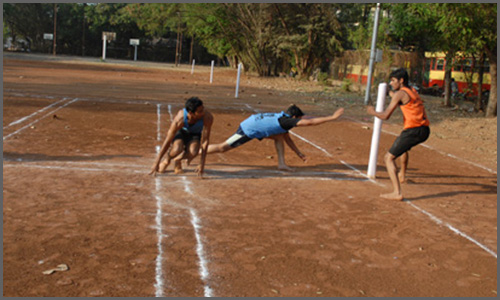
• Do not increase the speed of the chase by your running. Keep a constant & safe distance between you and attacker (safe means at-least a cross lane distance.)
• It is dangerous to go to Post from the back of the adjacent chaser.
• Prevail over the Judgment Kho by watching the attacker calmly and coolly. Concentrate on the rear leg of an attacker.
• Post is the dangerous point for all chain games. Reach to the post quickly and take a stance at post quickly.
• Avoid too much lift of the legs and use steps to avoid tapping.
• Start playing ‘game in four’ or ring game defense, if trapped in ‘two on Post’ position or clubbing, or the one on the Post must run away before the second defender is pushed towards the Post and as soon as the second seated chaser from the Post gets a ‘Kho’.
• Inactive defender should move to the opposite direction of the chase within 2nd to 5th Cross Lanes with side ward stepping and cautiously.
• Avoid action by Officials. Refrain from showing resentment in any manner over the decisions of Officials.
A highly skilled way of defense. A difficult skill to master. Perfect foot-work, swiftness and excellence in reflexes, sharp eyes, intelligence, and ability to respond instantaneously to the changing situation, are constantly demanded. Pace of the chase is considerably slowed down enabling the defender to defend at ease. In this defense the attacker is not on the back of the Defender but is boldly faced, rather challenged, face to face by the Defender. The Defender dodges and/or feints till he is safe from an attacker. Then he either tries to go beyond the attacker or crosses the Central Lane from the face of the fourth chaser. This backward run is rather angled, constantly facing the attacker.
After crossing the Central Lane the Defender turns the face and repeats the process in a manner that almost a circular ring path is carved between four players or Cross Lanes.
Depending upon the place where the defender starts the game, the types can be named ‘WIDE OPEN OR OPEN’ OR LONG RING type is played at a dead slow pace and begins nearer a side line and equally nearer to a Cross Lane of the first player in the ring. ‘SEMICLOSE’ or Medium Ring is faster paced and begins before or on the Cross Lane of the second player in the ring. ‘Close’ or Short Ring is fastest and encircles the middle two of the four in the ring.
It begins beyond the Cross Lane of the second player. In the three cases crossing the Central Lane is near, at half way and further from the fourth player in the ring towards the third player in the ring. Defender must ensure that the ‘Kho’ to the fourth seated chaser is dropped by an attacker. This will only allow him to complete the ring. If ‘Kho’ is given to the 2nd seated chaser, the ring should be started from the 3rd player in the ring as first player, reversing the direction of backward run. The game can be played clockwise or otherwise with the help of feinting and ‘face dupe turn’ or back dupe turn skill. In this skill even Post can be used as a fourth player. This skill is used by defender to slow down the speed of the chase.
Stance of the defender at the post is suitable for making a choice of running in either of the halves. A runner stands on toes a couple of feet away in the half of the first seated chaser facing line, joining the point where runner takes position and post-base would make an angle of about 300 with central-lane with nearest foot to the post should be in free zone, a distant one should be on the post-line, slight bend in knees and waist and concentrates the rear foot of the chaser on the first cross lane. Runner faces active chaser, holds post by the palm of the streched hand nearest to the post slightly bends in elbow. There would be normal distance between the legs of runner which gives him very stable posture.
Runners attentively observe the movements of active chaser. If Kho-Kho is given, his holding of post helps him going round the post in opposite half by pulling the post and using sideward stepping and if active chaser, without giving Kho, decides to chase by going round the post, defender runs away from him in the half he has taken his posture by pushing the post. Avoid the watching movements of hands or legs of the chaser. Defender should be very alert to face the chasing skills of Judgment Kho, Pole Dive etc.
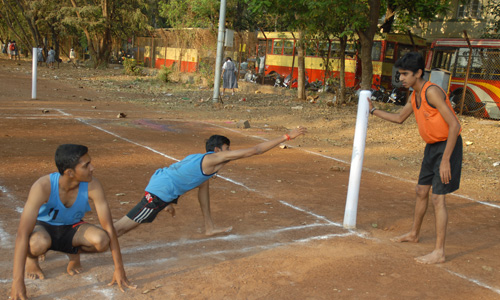
This is the action of prime importance in the game of Kho-Kho as chasers can utilize it to their advantage. ‘Turning the post’ consists of :